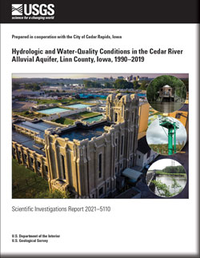Hydrologic and Water-Quality Conditions in the Cedar River Alluvial Aquifer, Linn County, Iowa, 1990–2019
Links
- Document: Report (16.7 MB pdf)
- Dataset: U.S. Geological Survey National Water Information System database — USGS water data for the Nation
- Data Release: USGS Data Release - Hydrologic and water quality data from the Cedar River and Cedar River alluvial aquifer, Linn County, Iowa, 1990–2019
- Download citation as: RIS | Dublin Core
Abstract
Alluvial aquifers in Iowa have more wells with nitrate exceeding drinking-water standards than other aquifers; are susceptible to contamination by organic contaminants; and have high concentrations of naturally occurring iron and manganese in depositional areas that contain abundant organic matter. The U.S. Geological Survey, in cooperation with the City of Cedar Rapids, Iowa, studied the Cedar River alluvial aquifer in Linn County, Iowa, from 1990 to 2019 to understand the effect of municipal pumping on spatial and temporal hydrologic and water-quality variability. The Cedar River alluvial aquifer is the source of water for the city of Cedar Rapids, Iowa. Withdrawal of large quantities of water for municipal and industrial supply has altered the normal flow of water in the alluvial aquifer. Pumping induces flow from the Cedar River and the underlying bedrock aquifer into the alluvial aquifer.
Water quality in the alluvial aquifer varies along the Cedar River. Changes in nitrate, ammonia, manganese, and iron in the alluvial aquifer are seen as the upstream free-flowing reach of the Cedar River transitions to a partially regulated downstream reach, likely because of differences in reduction-oxidation conditions in the aquifer, which are controlled by infiltration from the Cedar River under normal conditions and when wells are being pumped. Nitrate, normally found in oxygenated environments, had the highest concentrations in the most upstream wells in the Seminole well field and the lowest concentrations in the most downstream wells in the East well field. In contrast, ammonia, manganese, and iron, normally found in greatest abundance in anoxic (reducing) conditions, had the greatest concentrations in the most downstream wells. Additionally, dissolved nitrate plus nitrite nitrogen concentrations in wells were substantially less and manganese concentrations were greater in production wells near backwater wetlands in contrast to wells near the Cedar River.
Temporal variability in water quality in the alluvial aquifer was driven by pumping that increased flow from the Cedar River into the alluvial aquifer and ultimately led to changes in reduction-oxidation conditions of the aquifer. Increasing dissolved nitrate plus nitrite nitrogen concentrations in the Cedar River from 1990 to 2019 were mirrored in the alluvial aquifer. Anoxic conditions are prevalent in the alluvial aquifer next to the Cedar River when the aquifer is not under pumping stress. However, production well pumping caused induced infiltration of oxygenated river water into the aquifer resulting in increased dissolved nitrate plus nitrite nitrogen concentrations and pesticides and decreased naturally occurring dissolved iron and manganese.
Hydrologic and water-quality conditions in the Cedar River alluvial aquifer from 1990 to 2019 provide baseline conditions needed to evaluate the effects of current and future nutrient reduction efforts and land-use changes in the Cedar River Basin on water quality of the Cedar River alluvial aquifer and its source water, the Cedar River. This summary and analysis provide information that can assist the City of Cedar Rapids Utilities Water Department in managing groundwater resources, and provides information that could be used develop a groundwater-quality model to characterize variability over larger areas of the alluvial aquifer, allowing water providers to plan for future water needs of their users.
Suggested Citation
Kalkhoff, S.J., 2021, Hydrologic and water-quality conditions in the Cedar River alluvial aquifer, Linn County, Iowa, 1990–2019: U.S. Geological Survey Scientific Investigations Report 2021–5110, 61 p., https://doi.org/10.3133/sir20215110.
ISSN: 2328-0328 (online)
Study Area
Table of Contents
- Acknowledgments
- Abstract
- Introduction
- Description of the Study Area
- Description of the Alluvial Aquifer
- Methods
- Hydrology of the Alluvial Aquifer
- Water Quality of the Alluvial Aquifer
- Water Quality in Source Waters
- Relation Between Water Quality of the Alluvial Aquifer and the Devonian Aquifer
- Relation Between Water Quality of the Alluvial Aquifer and the Cedar River
- Flooding Effect on Alluvial Water Quality
- Summary and Conclusion
- References Cited
- Appendix 1. Pesticide Compounds Not Detected in the Cedar River Alluvial and Devonian Aquifers and the Cedar River near Cedar Rapids, Linn County, Iowa, 1990–2019
| Publication type | Report |
|---|---|
| Publication Subtype | USGS Numbered Series |
| Title | Hydrologic and water-quality conditions in the Cedar River alluvial aquifer, Linn County, Iowa, 1990–2019 |
| Series title | Scientific Investigations Report |
| Series number | 2021-5110 |
| DOI | 10.3133/sir20215110 |
| Publication Date | October 21, 2021 |
| Year Published | 2021 |
| Language | English |
| Publisher | U.S. Geological Survey |
| Publisher location | Reston, VA |
| Contributing office(s) | Central Midwest Water Science Center |
| Description | Report: ix, 61 p.; Data Release; Dataset |
| Country | United States |
| State | Iowa |
| County | Linn County |
| Other Geospatial | Cedar River Alluvial Aquifer |
| Online Only (Y/N) | Y |


